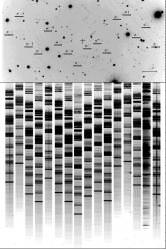The common belief is that all meteors come from inside our solar system. Most meteors are thought to be pieces of comet dust or fragments of asteroids that enter Earth’s atmosphere and burn up before they hit the ground, leaving a fiery trail we call “shooting stars.” But a recent observation might put a hole in the idea that these space rocks only come from the immediate vicinity of our solar system. A group of astronomers in Russia believe they observed a meteor of extragalactic origin.
On July 28, 2006, Victor Afanasiev from the Russian Academy of Sciences was making observations using a 6 meter telescope equipped with a multi-slit spectrometer. By chance, he observed the spectrum of a faint meteor as it burned up in the Earth’s atmosphere, and in looking at the data, found several anomalies. First was the speed at which the meteor was traveling. This meteor hit the atmosphere at about 300 kilometers per second, which is quite extraordinary. Only about 1% of meteors have velocities above 100 km/sec, and no previous meteor observations have yielded velocities of several hundred km/s. So where did this one come from?
Since the Earth moves around the galactic center at about 220 km/s, Afanasiev says the meteor’s origin cannot easily be explained by reference to the Milky Way. It appears that it came from the direction in which the Earth and the Milky Way is travelling towards the center of our local group of galaxies. “This fact leads us to conclude that we observed an intergalactic particle, which is at rest with respect to the mass centroid of the Local Group and which was ‘hit’ by the Earth,” Afanasiev and his team say in their paper.
Afanasiev also noted that the spectra of this meteor showed it was made of iron, magnesium, oxygen, iodine and nitrogen. These materials, particularly the metals, form inside stars. Additionally, spectral analysis showed features typical from the materials being strongly heated with the temperatures of 15000 – 20000K. Afanasiev says this differs widely from materials of terrestrial-type rocks and is suggestive of extrasolar or presolar materials.
Another difference was the size of the meteor. The researchers calculated that the meteor was several tens of a millimeter in size. This is two orders of magnitude larger than common interstellar dust grains in our galaxy. They estimated its size by integrating the equation of mass loss jointly with the equation of the variation of the density of the atmosphere. The research team noted that their size estimate, which they admit come from “rather coarse assumptions,” agrees with the expected parameters of the speed of interstellar meteors, which could be as high as 500 km/s.
The team subsequently made other observations to see if other meteors could perhaps be from outside our galaxy. In a total observing time of 34.5 hours during Oct-Nov 2006, they observed 246 meteors, 12 of which had velocity and direction to possibly have come from outside our galaxy.
Afanasiev and his team say there are many questions to be answered about their findings. For example, how metal-rich dust particles came to be in the extragalactic space, and why the sizes of extragalactic particles are larger by two orders of magnitude (and their masses greater by six orders of magnitude) than common meteors. Also, if extragalactic dust surrounds galaxies, could this be observed with infrared telescopes like the Spitzer Space Telescope? And is this dust spread out evenly in the universe or could it be found in clumps that might show up in the form of irregularities on the cosmic microwave background, observed by WMAP (Wilkinson Microwave Anisotropy Probe)?
With all our incredible observatories like Hubble, Spitzer, Chandra, etc, we have the opportunity to see outside of our galaxy. But now we have evidence that we actually might be interacting with extragalactic material as well.
Original News Source: Arxiv


My back of the envelope calculation, for Andromeda, gives a travel time of 1.5 billion years, and I think the object came from much further away. We need to capture some of these; they may be pieces from the early universe.
AFAIK the starts orbiting their galactic centre bob up and down, merry-go-round style, which could over the course of milennia pull bits of dust out of one system and fling them haphazardly into space.
I dread to think what would be left of the planet if a larger body (such as another star’s ‘cast away’ or stolen kuiper-belt-type object) were to rendezvous with us at several hundred kilometers per second!
At this speed, how big would something have to be to get to the surface?
It would be truly interesting to see and analyze but how would it be possible to stop such a cosmic bullet? It’s going at about 0.1% the speed of light. The kinetic energy is astronomical and even something with 1% of that energy (per mass) is going to totally evaporate itself and a much larger chunk of whatever it hits. I think the NASA types would have to do some significant rethinks and customizations to come up with a capture mechanism onboard a satellite.
As for origins, the extragalactic sounds intriguing as well. There are perhaps other possibilities as well. Something like a GRB or supernova might pulverize planets or blow away material surrounding the star at seriously high speeds as well.
do you known something named like chaved was seen in the year 1988 in the sky and was going in the speed of some 1000/hour on 4th of april
1000/? per hour? If MPH, that converts to just .45 km/s, or 447.04 m/s, much slower than this object…